Key takeaways:
- Community organizing is centered around empowerment, relationships, and inclusivity, where personal connections drive collective action.
- Active community engagement fosters belonging, ownership, and advocacy, transforming residents into informed participants in local issues.
- Effective organizing principles include building relationships, ensuring inclusivity for diverse perspectives, and having a shared vision to guide efforts.
- Adaptability, shared leadership, and the strength of personal connections are crucial lessons learned in community organizing efforts.
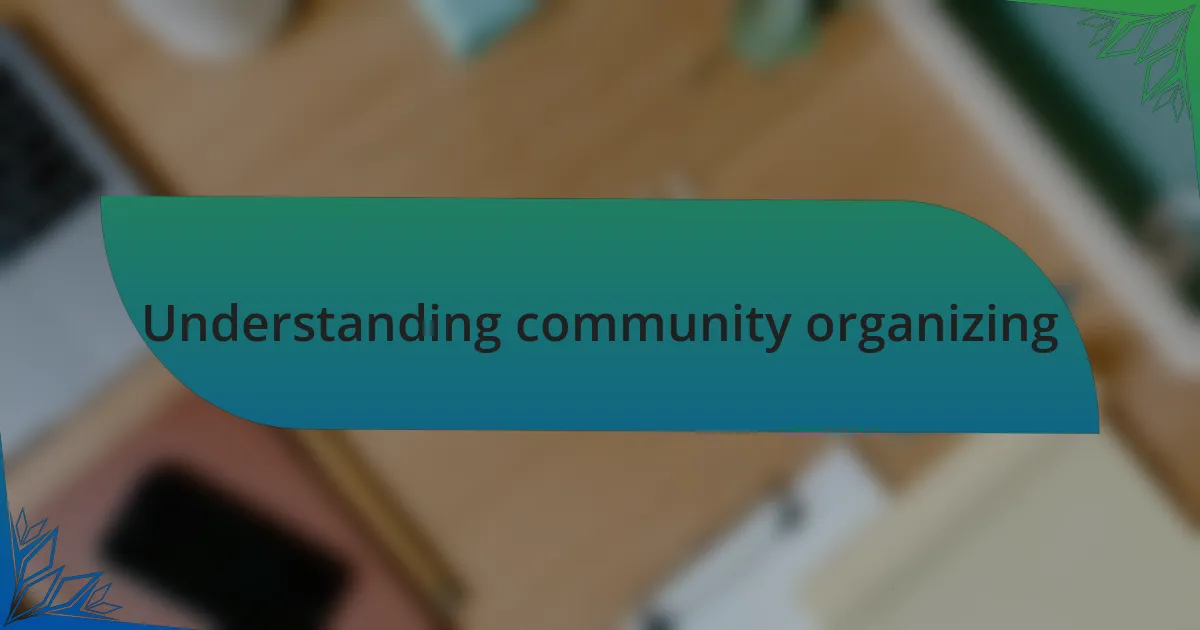
Understanding community organizing
Community organizing is fundamentally about empowerment. I vividly recall attending a local meeting where neighbors gathered to discuss persistent issues such as inadequate public transportation. It was incredible to witness how sharing personal stories transformed our collective frustration into actionable solutions, creating a palpable sense of hope.
At its core, community organizing thrives on relationships. I often found that the most impactful moments came from casual conversations over coffee or in the park, where trust is built. Have you ever thought about how personal connections can drive collective action? When individuals feel valued and understood, they are more likely to contribute ideas, and that’s when change truly begins.
Understanding community organizing also means recognizing the power of diversity. I once participated in a coalition that brought together people from various backgrounds. Each voice added a unique perspective, enriching our discussions and strategies. This experience taught me that inclusivity not only strengthens a movement but also leads to solutions that consider everyone’s needs. It makes you wonder—how can we create spaces where all voices are heard?
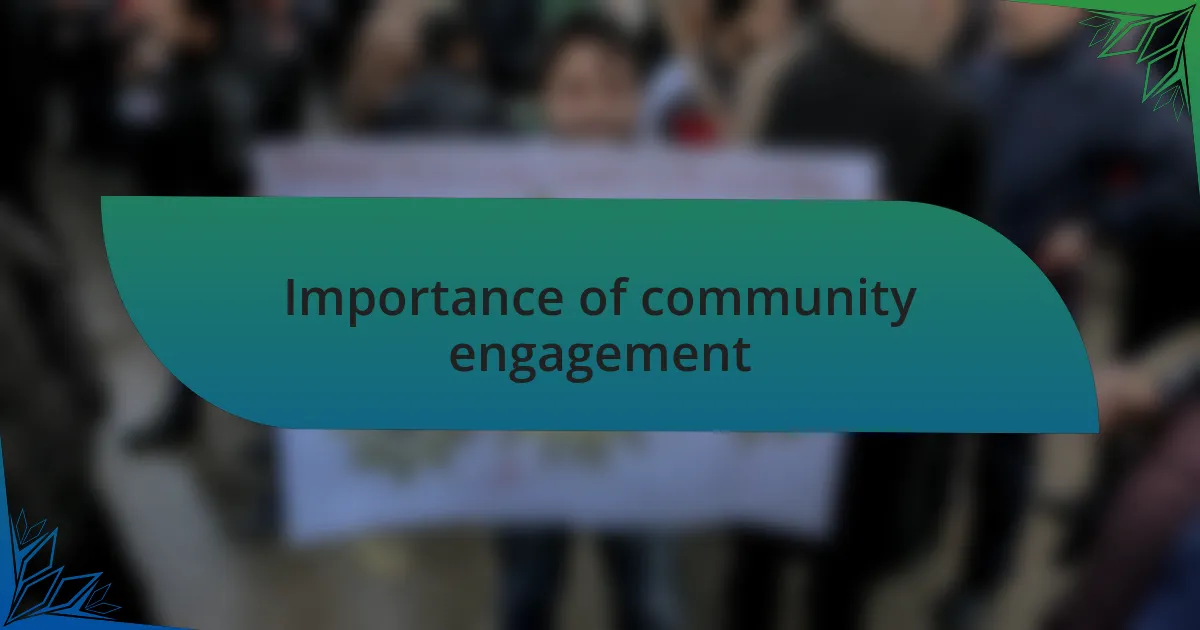
Importance of community engagement
Community engagement is crucial because it fosters a sense of belonging and ownership among residents. I remember a neighborhood cleanup event where we all rolled up our sleeves to pick up trash together. The laughter and camaraderie not only improved our environment but also deepened our connection to the place we call home. Can you imagine how that shared experience energized our community spirit?
When people get involved in local issues, they become informed advocates for change. I witnessed this firsthand during a campaign to improve public safety; residents banded together to address crime concerns in our area. Through organizing informational meetings, we not only educated ourselves but also empowered others to voice their concerns confidently. Isn’t it amazing how empowering knowledge can spark action?
Furthermore, community engagement acts as a catalyst for collaboration. I once joined forces with local artists to create a public art project that reflected our shared values. This collaboration brought together diverse talent and perspectives, resulting in a vibrant piece that everyone felt proud of. It makes me wonder—how many incredible initiatives could unfold if more communities embraced this spirit of collaboration?
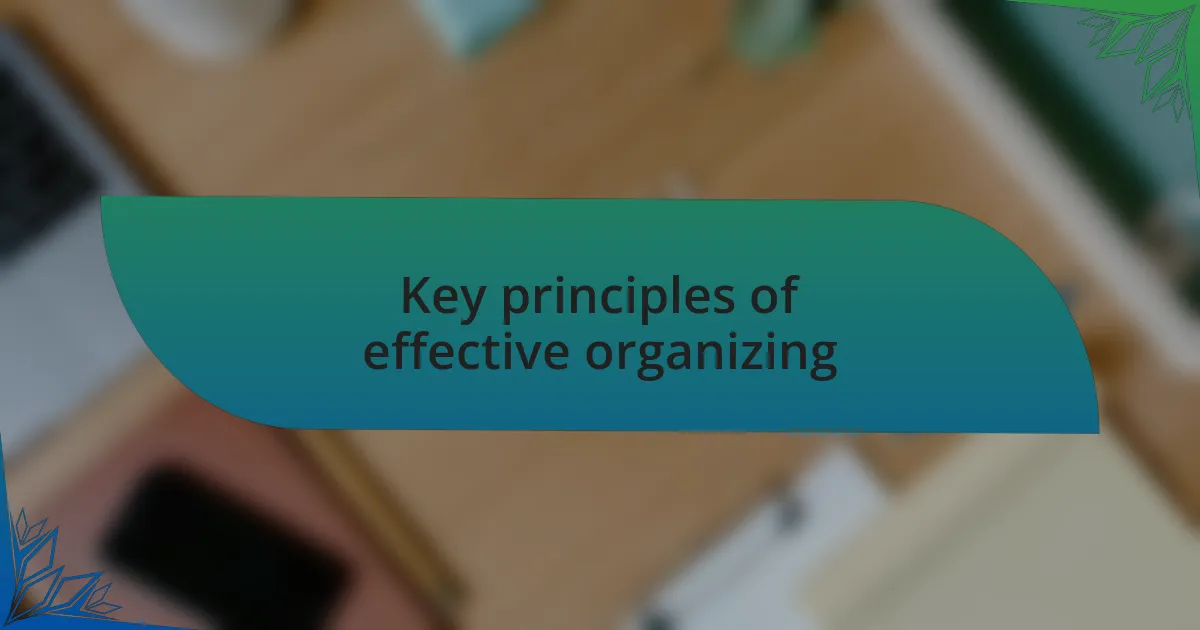
Key principles of effective organizing
Key principles of effective organizing revolve around building relationships. I recall a time when we decided to tackle food insecurity in our neighborhood. Rather than just handing out food, we took time to understand people’s stories and challenges. This connection not only created trust but also helped us gather insights that informed our approach. How can we effectively help if we don’t first listen to the needs of those we aim to serve?
Another essential principle is inclusivity. I once led a workshop aimed at enhancing community participation in local governance. By ensuring everyone felt welcome—regardless of age, race, or background—we witnessed a rich tapestry of perspectives emerge. The solutions we brainstormed reflected the collective wisdom of our community. When will we learn that diversity in voices enriches the conversation and leads to more effective solutions?
Finally, a clear vision is vital in organizing efforts. During a campaign to revitalize our park, we developed a shared vision that encapsulated everyone’s hopes for the space—a safe haven for children and a gathering spot for families. This clarity fueled our momentum, drawing volunteers and supporters. Can’t you see how a unified vision can spark enthusiasm and drive action in ways that scattered efforts simply cannot?
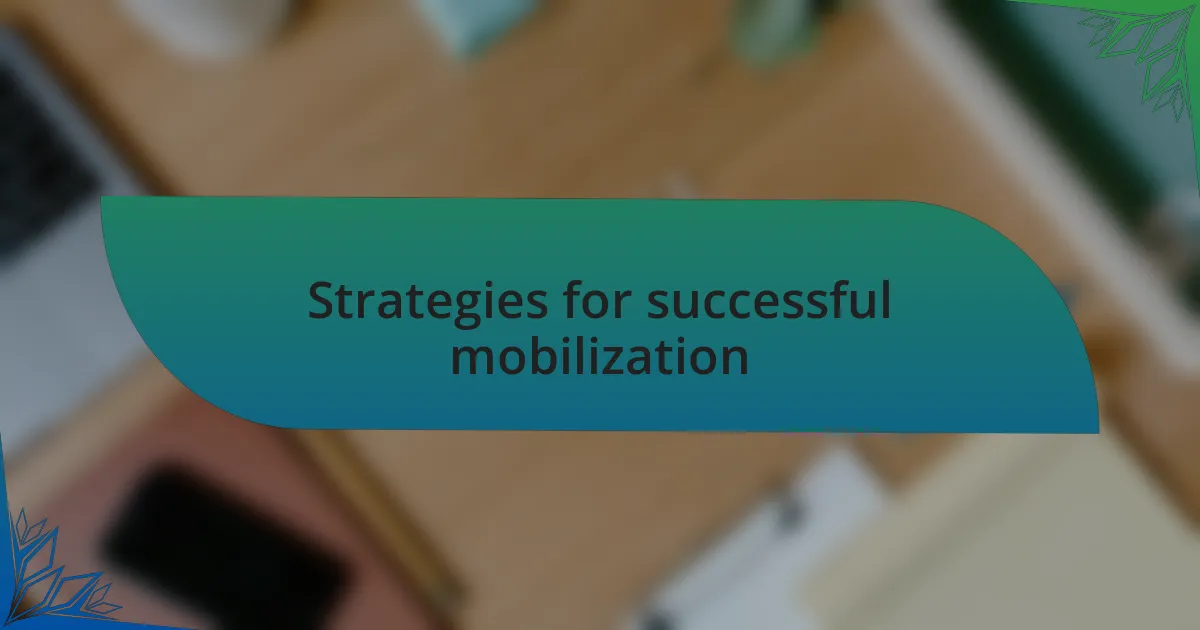
Strategies for successful mobilization
Mobilization is all about tapping into community energy, and one strategy that has always resonated with me is leveraging local leaders. In my experience, when we identified and empowered individuals who already had a foothold in the community, it was like igniting a spark. I remember a small community meeting where an elder, known for his storytelling, galvanized a reluctant crowd simply by sharing his own experiences. How often do we underestimate the power of relatable voices in rallying others?
Another effective strategy I’ve found is the use of social media to build momentum. A few years ago, we launched a campaign using a dedicated Facebook group to share updates, success stories, and upcoming events. The real magic happened when community members began to share their own posts, creating a sense of ownership. Can you imagine how a simple online platform can morph into a vibrant hub for activism and solidarity?
Then there’s the importance of creating tangible actions that everyone can participate in. I vividly recall organizing a community cleanup day—simple, yet effective. We all wore matching t-shirts, which transformed the event into more than just cleaning; it became a collective identity. When was the last time you witnessed a small act grow into a powerful statement of community pride and unity?
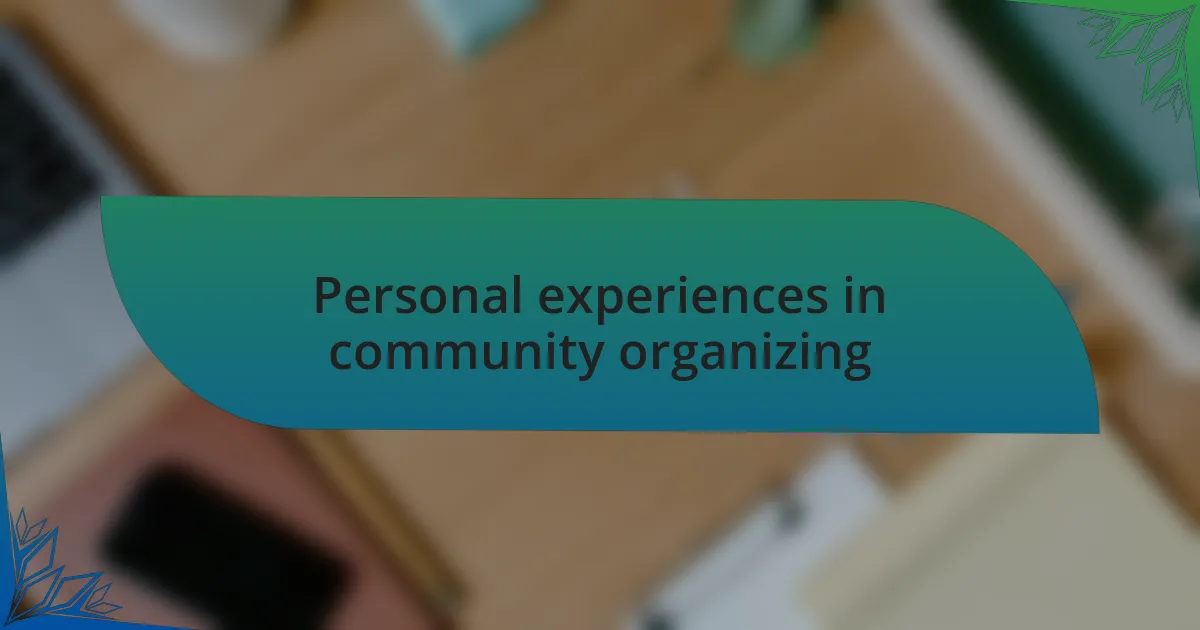
Personal experiences in community organizing
The first time I stepped into a community organizing role, I was struck by the sheer diversity of experiences that people brought to the table. I remember sitting in a cramped room with passionate activists from various backgrounds, each sharing their struggles and victories. It struck me that every story was a thread in a larger tapestry; how could I have ever thought my voice was the only one that mattered? That realization deepened my understanding of inclusivity and how vital it is to foster an environment where everyone feels valued.
One particularly memorable experience was when we organized a neighborhood forum to discuss local issues like housing and public safety. I distinctly recall an intense discussion sparked by a single parent’s perspective on affordable housing. Her heartfelt account made the issue personal for many attendees, shifting the energy from mere conversation to a collective determination for change. Isn’t it amazing how one genuine story can activate a room full of people, encouraging them to turn their empathy into action?
Reflecting on these experiences, I find it essential to emphasize the role of follow-up and continuous engagement. After that forum, we created smaller action groups based on expressed interests, which not only kept the momentum alive but also built friendships among participants. I often wonder: how many relationships have I forged through shared purposes and challenges? Engaging with others in this way has been a fundamental aspect of my growth as an organizer, creating a network that feels more like family than just allies.
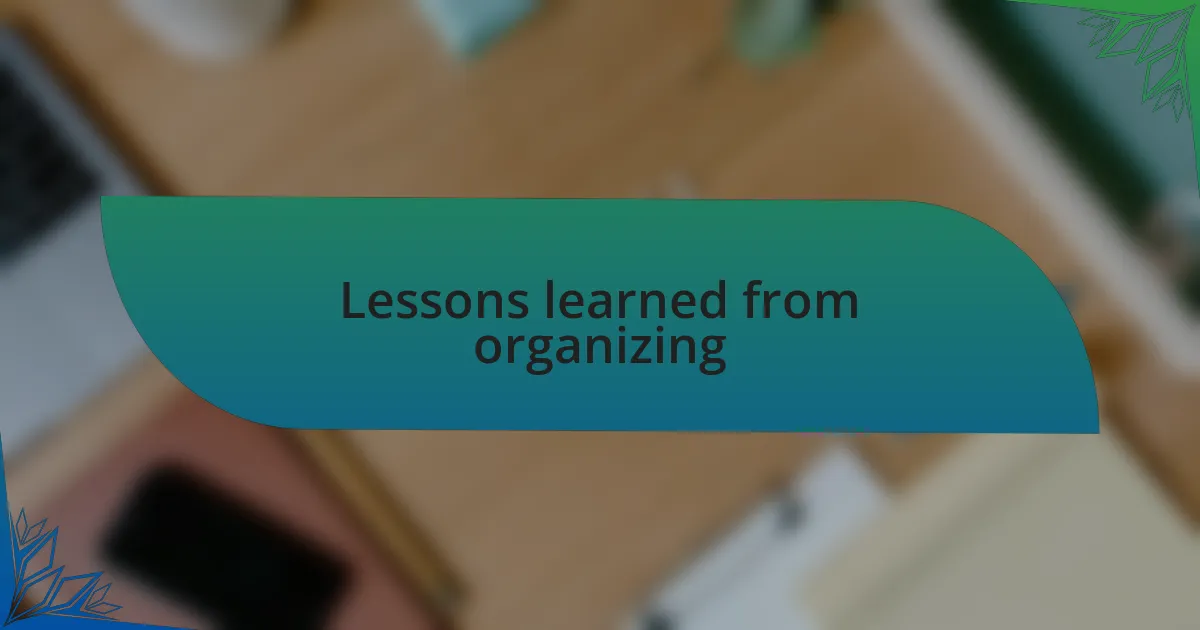
Lessons learned from organizing
One critical lesson I’ve learned in community organizing is the importance of adaptability. I vividly recall a rally we planned, anticipating a large turnout. Instead, a thunderstorm struck just before the event, and we had to pivot quickly. It was during that chaotic moment that I realized the real strength of our organizing wasn’t in rigid plans but in our ability to adjust and respond to the unexpected. Have you ever faced a situation that made you rethink your approach?
Another key insight is the power of shared leadership. In one initiative, I decided to step back and allow others to lead discussions. To my surprise, not only did it spark a wealth of ideas, but I also witnessed individuals stepping out of their comfort zones. I felt a profound sense of fulfillment seeing them shine. It underscored for me a vital truth: leadership is most effective when it flows among many, rather than being held by one person alone.
Lastly, never underestimate the strength of personal connections. I remember organizing casual meet-ups where people simply shared stories over coffee. Those seemingly informal gatherings transformed into safe spaces for vulnerability and trust. It struck me how these connections laid the groundwork for more significant activism. How many times have you underestimated the potential power of conversation? Each interaction was more than just small talk; it wove a fabric of solidarity that has only strengthened our collective efforts.
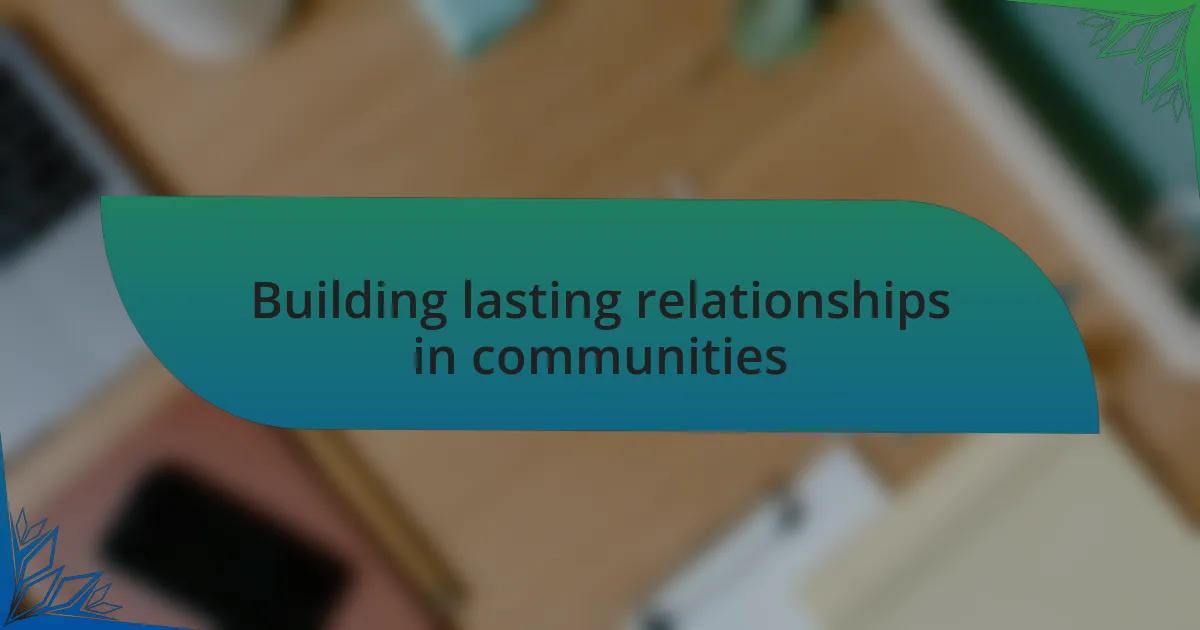
Building lasting relationships in communities
There’s something magical about investing time in one-on-one interactions within the community. I recall a day spent at our local park, simply chatting with neighbors about their hopes or frustrations. It was then that I realized these conversations are not just pleasantries; they’re essential building blocks. Every person I spoke with had a unique story that contributed to our shared identity, and I could feel the walls of mistrust melting away. Have you ever taken a moment to truly listen?
Building relationships in communities often means being present in the mundane. I remember participating in a book club that started as just a gathering of avid readers, but it soon evolved into a support network. We discussed not only our latest reads but also personal challenges and dreams. Those meetings became a lifeline. I learned that building genuine connections isn’t just about sharing interests; it’s about creating a safe space for vulnerability, where everyone feels valued. Can you think of a group that has enriched your life in similar ways?
Sometimes, the smallest gestures yield the most profound results. I initiated a simple “bring a dish” potluck for my neighbors, which felt like a small step at the time. However, what blossomed was a vibrant tapestry of our diverse backgrounds and cultures. People didn’t just bring food; they brought stories and laughter that filled the evening air. It was eye-opening to see how food—not just a meal, but a shared experience—fostered a sense of belonging. How often have you seen a simple act connect people in unexpected ways?